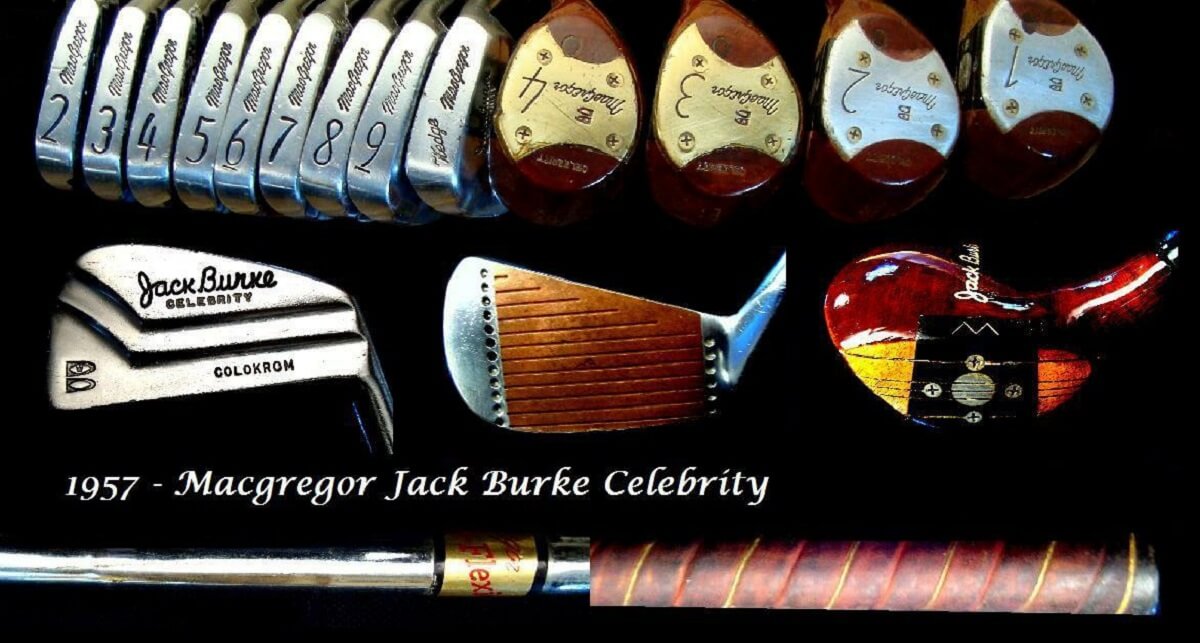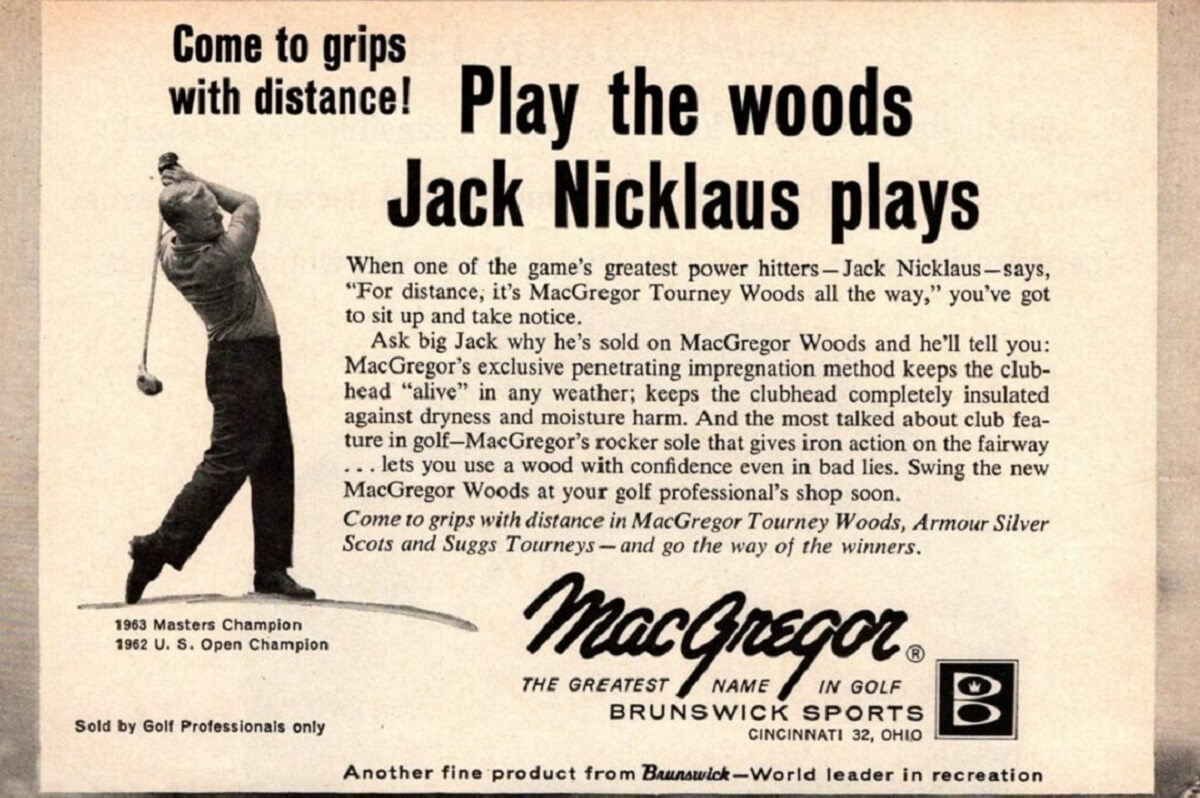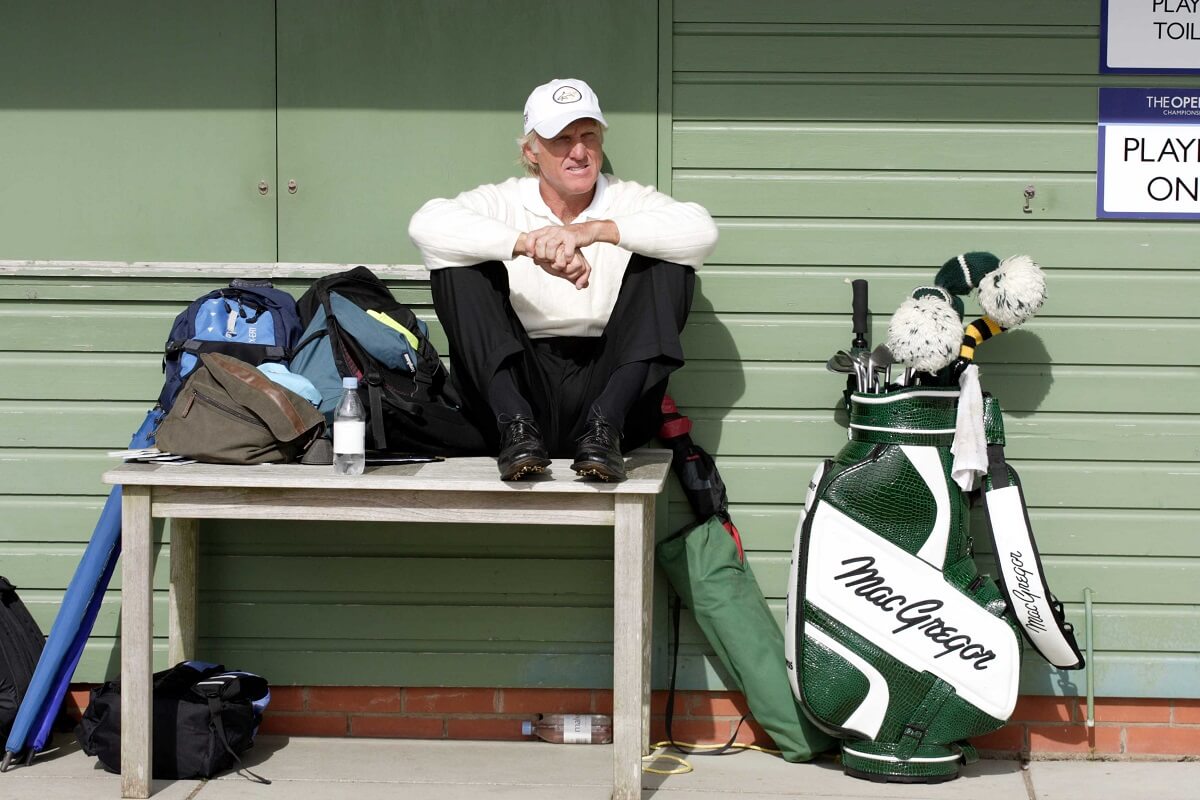Welcome to the first official installment of what we at MyGolfSpy hope will become a favorite of yours: History’s Mysteries.
It’s easy to care only about today. But historical perspective helps us connect certain dots while disconnecting others. By peering through the lens of time, we can better understand just why the golf industry is the way it is and how it got here.
Our first subject is, next to Wilson Staff, the most iconic name in golf’s long, fascinating history: MacGregor Golf.
History’s Mysteries: MacGregor Golf
Wilson Staff famously touts more majors won than any other brand. Their total of 62 is mostly frontloaded but it is an impressive number.
But did you know MacGregor is No. 2 with 59?
MacGregor’s history dates all the way back to 1829. That’s when English immigrants and expert wood craftsmen Archibald and Ziba Crawford founded the Dayton Last Company in Dayton, Ohio. A last is a wooden, foot-shaped form used in shoe manufacturing and repair and the Crawfords made good ones. They were also quite innovative, developing a unique lathe that could make lasts faster and more precisely. That lathe would later play a huge role in golf history.
From Shoes to Golf
The Crawford heirs eventually brought in two new partners to their company: John McGregor (note the spelling) in 1875 and Edward Canby in 1886 to eventually form the Crawford, McGregor and Canby Company. McGregor was a Scottish immigrant from St Andrews and a hardcore golfer. He eventually got Canby hooked on the game, setting the wheels in motion. In 1897, Crawford, McGregor and Canby introduced its first golf club—a wood made using the Crawford lathe.
By 1910, Crawford, McGregor and Canby had become a major force in golf as well as the world’s largest shoe last maker. In fact, the company was exporting more than 100,000 clubs a year to the U.K. By the Roaring ’20s, golf blew past shoe lasts in revenue. And by the end of the decade, Archibald and Ziba’s company had made its last shoe last.
The Market Changes
By 1927, retail golf sales exceeded pro shop sales for the very first time. Crawford, McGregor and Canby went all in, mass-producing low-cost, high-profit clubs. Record sales and profits followed and everything was looking rosy.
Until the Great Depression.
By 1932, the bottom had dropped out of retail and, by 1934, Crawford, McGregor and Canby was facing bankruptcy. Edward Canby died and the company went up for sale. Chief competitor Wilson put in a bid but the company was ultimately sold to sporting goods giant Goldsmith. A new management team was brought in, headed up by Clarence Rickey (cousin of Branch Rickey, who would later break baseball’s color barrier by signing Jackie Robinson).
Rickey’s team officially renamed and re-spelled the company “MacGregor.” The reason was simple. The Depression wiped out retail but club pros were still moving product. Most of those pros were Scottish immigrants and “MacGregor”, quite simply, sounded more Scottish. One Scotsman, in particular, was in Rickey’s crosshairs: Medinah head professional Tommy Armour.
Rickey knew Armour from Medinah and from his days with the Burke Golf Company in Chicago. Their partnership would produce the very first Tommy Armour Silver Scot irons. And just to show history has a sense of humor, decades later Burke would morph, ironically, into the Tommy Armour Company.
MacGregor Goes KA-BOOM!
With Armour and his assistant, Toney Penna, onboard, MacGregor soon exploded. Penna played MacGregor clubs on the PGA TOUR and recruited other Tour players to join him. He hit the jackpot in 1939 when he signed Jimmy Demaret, Byron Nelson and Ben Hogan.
After World War Two, MacGregor moved from Dayton to Cincinnati. Tommy Armour was the game’s top-selling pro club while Nelson, Hogan, Demaret and LPGA original Louise Suggs all had their names on MacGregor clubs. From 1947 through 1960, more touring pros used MacGregor clubs and balls than all others combined.
In 1950, MacGregor introduced the Penna-designed MT irons. As a designer, Penna was ahead of his time. His MT irons were compact blades with a relatively thick topline. They featured a very low CG and—prepare to be outraged—jacked lofts. They were so popular that MacGregor had to stop making tennis equipment to free up more space for golf club production.
Other MacGregor firsts during the 1950s: Oversized Eye-O-Matic woods with tri-colored inserts, Colorkrom irons with a copper face, the Pro-Pel shaft, colorful kangaroo leather bags and shoes and the first all-weather rubber and cord grip.
Brunswick, Jack and the Beginning of the End
In 1958, MacGregor was sold to bowling giant Brunswick. Owner Ted Bensginer made a killing when he developed the first automatic pinsetter and started buying up companies to grow his empire.
One of the new ownership’s first moves was to shift golf production out of Cincinnati and away from its labor unions to Albany, Ga. Golf ball, basketball and football manufacturing was moved to Covington, Ga. While the move did quadruple production capacity, it also required an entirely new workforce.
The first few years under Brunswick were a mess. A new accounting system nearly killed the company, causing $12 million in losses in just three months. Salespeople saw their pay structure changed, prompting many to leave MacGregor for Acushnet.
The ship eventually stopped rocking long enough for MacGregor to sign Jack Nicklaus in 1962 to one of the first big-money equipment deals in golf: a staggering $100,000 for five years.
MacGregor had the hottest new golfer on the planet in its stable of professionals. With Jack about to embark on the greatest run of golf ever, MacGregor should have been sitting pretty. In truth, however, MacGregor was sitting on a house of cards.
The Not-So-Swingin’ 60s
“Those who cannot remember the past are doomed to repeat it.” Philosopher George Santayana
As far as decades go, the ’60s were not all that kind to golf. Over-production was an industry-wide problem and, in 1964, MacGregor was forced to liquidate 50 percent of that year’s product. The equipment glut led to the birth of off-course discount golf retailers. Those retailers would scoop up excess inventory at a bargain and sell it for less than club pros could buy it for.
As it did in 1927, MacGregor dove headfirst into retail. And, just as in 1927, club pros were understandably pissed. MacGregor’s pro shop gear was all custom made and of higher quality than the retail stuff but average golfers only saw the 25-percent premium.
At the same time, Karsten Solheim was making investment casting a thing. It was faster, easier, less expensive and made perimeter weighting doable. Penna, in fact, brought up the idea of investment casting in the ’50s but management dismissed the idea. Frustrated, Penna eventually left MacGregor to start his own company.
Moreover, Brunswick’s schizophrenic management style was taking its toll. At one point, MacGregor had five different presidents during an 18-month span. The company also struggled with quality issues at the new Albany plant, issues that would plague the company on and off for the rest of its existence.
The Ownership Carousel
In 1978, Brunswick sold MacGregor to the Wickes Corporation. Wickes was a world leader in lumber sales and owned Snyder Drug and Red Owl supermarkets. Several of Wickes’s top brass were golf nuts so MacGregor seemed like the perfect toy.
Unfortunately, Wickes was swimming in debt. In April of 1982, Wickes sold the company to Nicklaus and Wickes VP Clark Johnson. Thirty days later, Wickes filed for Chapter 11, at the time the largest bankruptcy filing in U.S. history.
Nicklaus had been heavily involved in MacGregor throughout the ’70s. He brought Jack Wullkotte, his personal club maker, back from Toney Penna in ’74 to oversee operations and he hired David Graham as chief designer. Together, they designed the VIP irons, which Graham used to win his two majors, and the Jack Nicklaus Limited Edition irons. Jack won two majors with those.
Clay Long was also part of the MacGregor team during those years. Chi Chi Rodriguez used Long’s oversized CG-1800 irons to win a bunch of Senior Tour events. And Long is best known for the Response ZT putter Jack used to win the ’86 Masters. The company figured it might sell about 6,000 Response ZTs but, by noon the day after the Masters, MacGregor had orders for 5,000. The company sold 150,000 the first year and 350,000 over three years. It was the single biggest seller in MacGregor history.
Amer and Irrelevance
MacGregor was making money again but Jack’s golf course business was in a jam. Specifically, the St. Andrews project in New York was becoming a money pit and Jack needed cash fast. So, in 1988, he sold 80 percent of MacGregor to the Amer Group from Finland for $8 million—the same Amer that would also buy Wilson Sporting Goods. Three years later, fed up with what he felt was lousy retail product, Jack sold his last 20 percent to Amer.
Amer’s stewardship of MacGregor didn’t make it through the ’90s. There was talk of folding MacGregor into Wilson but, in 1996, Amer sold MacGregor to Masters International Ltd. for $20 million. Two years later, Masters sold MacGregor to business maverick Barry Schneider for $42 million.
To his credit, Schneider made sweeping and long overdue changes. He phased out low-end lines, which accounted for millions in revenue, and focused on returning to MacGregor’s forged premium roots.
“I don’t want to be the biggest, just the best,” he was quoted as saying at the time.
Schneider and The Shark
The Schneider years were a roller coaster for MacGregor. Big TV ad campaigns alternated with big cutbacks. Message and marketing consistency was long gone as MacGregor ran through eight ad agencies in 15 years. Schneider tried dumping the company in 2000 but found no takers. Two years later, he went all in again with a $10-million ad budget, in-store marketing, college team sponsorships and more than 1,200 demo days nationwide.
In 2003 Schneider brought Bobby Grace Putters into the fold and, by 2006, the company thought it had found its savior in Greg Norman. Even when the Shark was under contract with Cobra, he had MacGregor’s legendary Don White grind his irons for him. Within two years, Schneider was out and Norman was named chairman of the board.
“I underestimated the strength of existing brands in a consolidating industry,” Schneider said at the time.
Norman had big plans for a turnaround, dumping the low-end MacTec line and reviving MT irons. And there were plans to resurrect the VIP line in 2009. Unfortunately, the real world intervened in the form of a near-global financial collapse. By spring, the writing was on the wall. The chairman jumped overboard and signed a deal with TaylorMade. And in yet another example of the cosmos having a sense of humor, the former Goldsmith-MacGregor company was sold to golf retailer Golfsmith for less than $2 million.
The 112-year-old industry icon was now a store brand.
Golfsmith To DICK’S
“We have great respect for the history and tradition of the brand,” said Golfsmith VP David Lowe in the May 22nd issue of Golf Digest. “We’re going to make product that is consistent with its history.”
Golfsmith’s heart was in the right place. It assigned R&D to its partner, Jeff Sheets Design. The result was one last gasp, the 2010 MacGregor VIP forged cavity back. A titanium driver with a 360 cup face and a series of hybrids, fairways, wedges and putters followed. But the die was cast. MacGregor was a store brand and real golfers don’t buy store brands.
Golfsmith filed for bankruptcy in 2016. Ultimately, DICK’S Sporting Goods snapped up all its assets.
Where does that leave the MacGregor brand? That’s a good question and one we posed to David Michaels, DICK’S Senior Manager of Business Development. His answer was simple and straightforward.
“I’m not sure of the current situation of that brand.”
As John Cleese might say, this is a dead parrot.
What Killed MacGregor?
As with most business failures, you have the usual suspects: scattershot ownership, rudderless management, late-to-the-party innovation and ineffective marketing. Take your pick. They’re all valid. But the real reason is much simpler.
All businesses ebb and flow but the ones that last constantly challenge themselves by asking, “What business are we really in?” Seems simple enough but it’s an easy question to get wrong. MacGregor thought it was in the business of getting people to buy the golf equipment it made. However, it was most successful when Penna and company were developing golf equipment people wanted to buy.
There’s a difference.
By the ’90s, Callaway, TaylorMade and COBRA were making golf equipment people wanted to buy. They were new, exciting and innovative. MacGregor was viewed as being none of those. Even though it was the first company to design a driver using a computer in the early ’90s, people stayed away in droves.
“They were using something called the Cray Computer,” says Bob Winskowicz, founder of SQAIRZ golf shoes and a regional sales manager for MacGregor during the Amer years. “It analyzed what happened when the ball and club met at impact. What they saw was the clubhead expanding significantly and the ball compressing to about half its size.”
MacGregor used that information to develop the Mad Mac.
“It had these gears on the top of the head and ribs at the bottom and they were connected internally,” Winskowicz tells MyGolfSpy. “The computer showed stress points and those stress points meant a lack of energy being transferred to the ball. Fast forward to today and Callaway is marketing the same thing with Jailbreak. Their rib technology delivers more ball speed.
“MacGregor did this back in the ’90s.”
But, by then, it was too late.
History’s Mysteries: Time Passages
“Those who fail to learn from history are doomed to repeat it.” Winston Churchill
MacGregor Golf is dead and buried but a few folks do miss it. Every April through July, I screw around with new irons that catch my fancy, hoping to find a new magic bullet. But, like clockwork, August comes and I go back to my one true love: the 2002 MacGregor V-Foil VIPs. They remain MacGregor’s last hurrah.
It’s hard for 100-year-old brands to be thought of as innovative or cutting edge, even if they are. Once the market decides you’re not innovative, you’re not innovative. It’s different now but in the 1950s through the 1990s, breakthrough innovation came from upstarts who had nothing to lose. Mainstays like MacGregor were too invested in the status quo. Their innovations wound up a day too late and a dollar too short.
MacGregor’s foray into metalwoods is a prime example. MacGregor owned the premium woods market from the Crawford Shoe Last days until 1988 when the first metalwoods showed up on Tour. Then it didn’t. In just nine months, MacGregor’s woods production dropped from 1,200 per day to 50 per week.
MacGregor did introduce golf’s first cast titanium driver, the T-920, in 1992. That, however, came a full year after the force of nature that was the Big Bertha, so no one cared. Callaway didn’t go full titanium until the Great Big Bertha in 1995. That year Callaway sold more than 250,000 GBBs. MacGregor sold only 2,500 T-920s.
Today, nearly all innovation comes from the big companies, simply because they have the R&D juice to do it. The New Age Ely Callaways of the world simply don’t. You can debate whether that’s a good thing but it certainly behooves the Big Five and the others to remember Santayana’s and Churchill’s warnings: Learn from the past or repeat it.
And remember what business you’re really in.
History’s Mysteries: Your Turn
We hope you enjoyed this installment of History’s Mysteries and our take on MacGregor’s downfall. Please let us know your recollections of MacGregor and, if you have any suggestions for future deep dives into golf’s historic brands, clubs or events, please let us know.
(Note: The worldwide web has been a tremendous help in researching this article. For an even deeper dive, we recommend Robert Rickey’s History of MacGregor: 1929 to 1979, and Adam Schupack’s seminal piece for Golfweek.)


























Tim Hubert
2 years ago
No logical person is outraged at “jacked-up” lofts … we just don’t see the need for them. My first set of clubs were 1988 Wilson Staffs (3-PW) and were probably “jacked-up” from earlier sets but the 3 iron was 21* and PW was 50*. Now, “jacked-up” 8 club sets are 4-GW or even 5-GW2 but still cover basically the same lofts … 21* to 50*. If you’re playing a 32* club, who cares if it’s marked 6 or 8?